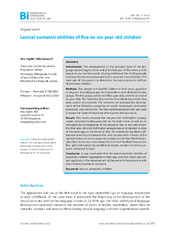Prikaz osnovnih podataka o dokumentu
Lexical-semantic abilities of five-to-six-year-old children
Leksičko-semantičke sposobnosti dece uzrasta od pet do šest godina
| dc.creator | Vuković, Mile | |
| dc.creator | Jegdić, Ana | |
| dc.date.accessioned | 2024-01-10T13:09:14Z | |
| dc.date.available | 2024-01-10T13:09:14Z | |
| dc.date.issued | 2023 | |
| dc.identifier.issn | 1986-8529 | |
| dc.identifier.issn | 1986-8537 (Online | |
| dc.identifier.uri | http://rfasper.fasper.bg.ac.rs/handle/123456789/5349 | |
| dc.description.abstract | Introduction. The development of the semantic level of the lan- guage system begins at the end of the first year of life, when a child begins to use the first words. During childhood, the child gradually increases his/her vocabulary and learns semantic characteristics. The main aim of this paper is to determine the lexical-semantic abilities of preschool children. Methods. The sample included 50 children of both sexes, aged five to six years. According to age, the respondents were divided into two groups. The first group consisted of five-year-olds, and the second of six-year-olds. The Semantic Test and the Free Word Association Test were used in the research. The semantic test assessed the develop- ment of the following categories of words: homonyms, antonyms, synonyms, and metonyms. The free word association test was used to assess the types of responses after a given stimulus word. Results. The results showed that six-year-olds had higher average values compared to five-year-olds on the total score, as well as on individual lexical categories of the Semantic Test. It was also shown that five-year-old girls had higher average values compared to boys of the same age on the Semantic Test. No statistically significant dif- ferences were found between five- and six-year-olds in terms of the representation of certain types of answers on the Free Word Associ- ation Test. As for sex, it was shown that on the Free Word Association Test, girls had statistically significantly higher number of missing an- swers compared to boys. Conclusion. It was concluded that the lexical-semantic abilities of preschool children depended on their age, and that there was cer- tain regularity in the development of the semantic features of words and the lexical-semantic structure. | sr |
| dc.description.abstract | Uvod. Razvoj semantičkog nivoa jezičkog sistema počinje krajem prve godine života, kada dete po- činje da upotrebljava prve reči. Tokom detinjstva dete postepeno uvećava fond reči i saznaje njihova semantička obeležja. Cilj ovog rada jeste da se utvrde leksičko-semantičke sposobnosti kod dece predškolskog uzrasta. Metode. U uzorak je uključeno 50 dece, oba pola, uzrasta od pet do šest godina. Prema uzrastu, ispitanici su podeljeni u dve grupe, prvu grupu činili su petogodišnjaci, a drugu šestogodišnjaci. U istraživanju su korišćeni Semantički test i Test slobodnih asocijacija reči. Semantičkim testom je pro- cenjivana razvijenost sledećih kategorija reči: homonim, antonim, sinonim i metonim, dok su Testom slobodnih asocijacija reči ispitivane vrste odgovora nakon date stimulus reči. Rezultati. Utvrđeno je da šestogodišnjaci imaju veće prosečne vrednosti u odnosu na petogodišnja- ke na ukupnom skoru, kao i na pojedinačnim leksičkim kategorijama Semantičkog testa. Takođe je pokazano da devojčice uzrasta pet godina na ovom testu imaju veće prosečne vrednosti u poređe- nju sa dečacima istog uzrasta. Na Testu slobodnih asocijacija reči nisu utvrđene statistički značajne razlike između petogodišnjaka i šestogodišnjaka u pogledu zastupljenosti pojedinih vrsta odgovora. Što se tiče pola, pokazano je da na Testu slobodnih asocijacija reči devojčice imaju statistički značaj- no više izostanaka odgovora na datu stimulus reč u poređenju sa dečacima. Zaključak. Zaključeno je da leksičko-semantičke sposobnosti dece predškolskog uzrasta zavise od uzrasta, te da postoji određena zakonomernost u razvoju semantičkih obeležja reči i leksičko-seman- tičke strukture. | sr |
| dc.language.iso | en | sr |
| dc.publisher | Univerzitet u Beogradu – Fakultet za specijalnu edukaciju i rehabilitaciju/ University of Belgrade – Faculty of Special Education and Rehabilitation | sr |
| dc.relation | info:eu-repo/grantAgreement/MESTD/Basic Research (BR or ON)/179068/RS// | sr |
| dc.rights | openAccess | sr |
| dc.rights.uri | https://creativecommons.org/licenses/by-sa/4.0/ | |
| dc.source | Biomedicinska istraživanja | sr |
| dc.subject | lexicon | sr |
| dc.subject | semantics | sr |
| dc.subject | children | sr |
| dc.subject | leksikon | sr |
| dc.subject | semantika | sr |
| dc.subject | deca | sr |
| dc.title | Lexical-semantic abilities of five-to-six-year-old children | sr |
| dc.title | Leksičko-semantičke sposobnosti dece uzrasta od pet do šest godina | sr |
| dc.type | article | sr |
| dc.rights.license | BY-SA | sr |
| dc.citation.epage | 208 | |
| dc.citation.issue | 2 | |
| dc.citation.spage | 197 | |
| dc.citation.volume | 14 | |
| dc.identifier.doi | DOI: 10.59137/BII202302339J | |
| dc.identifier.fulltext | http://rfasper.fasper.bg.ac.rs/bitstream/id/10914/bitstream_10914.pdf | |
| dc.type.version | publishedVersion | sr |


